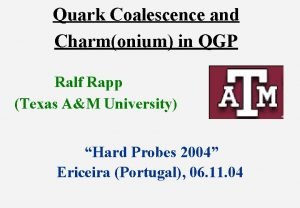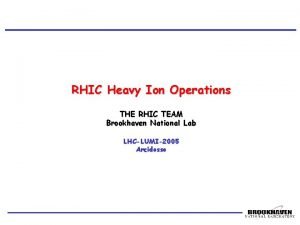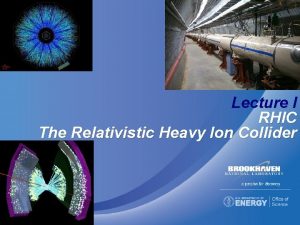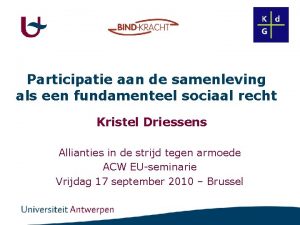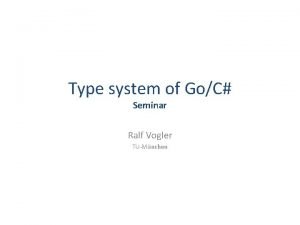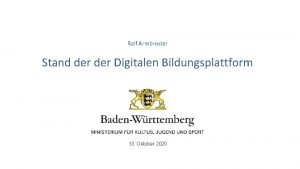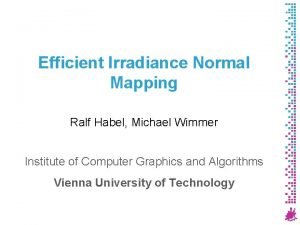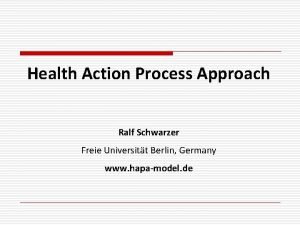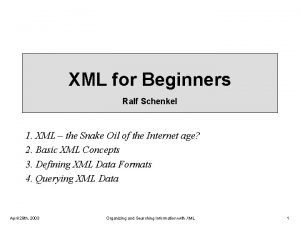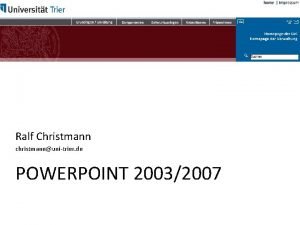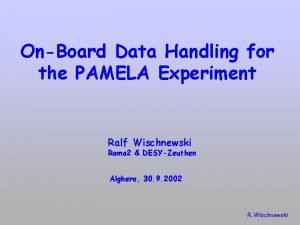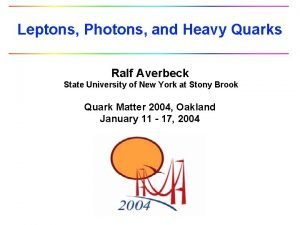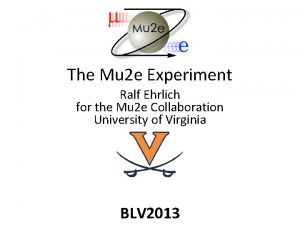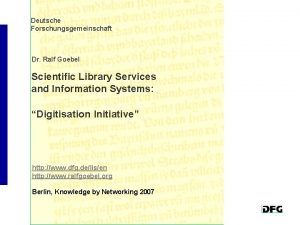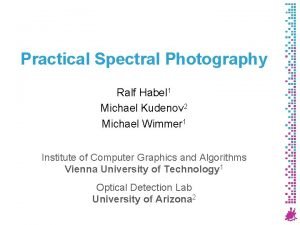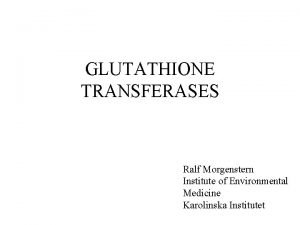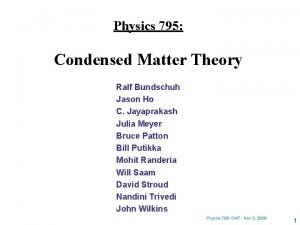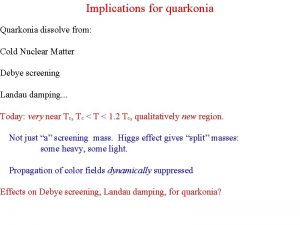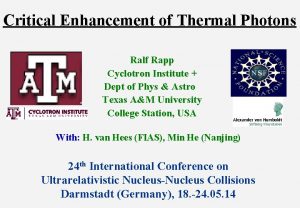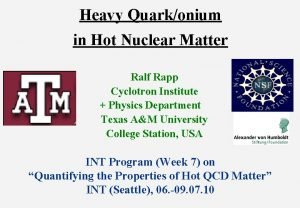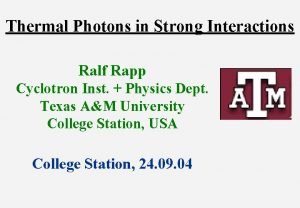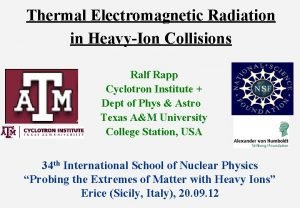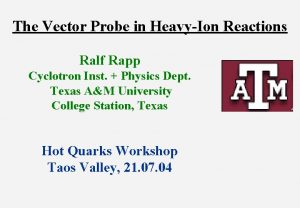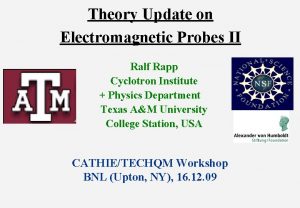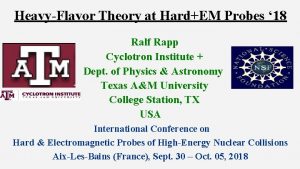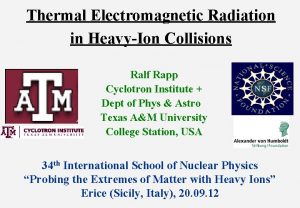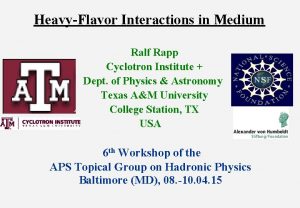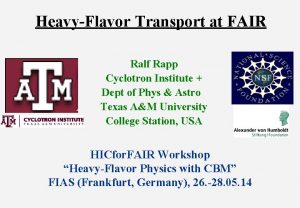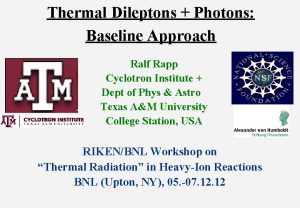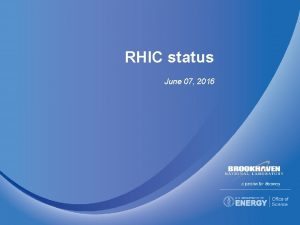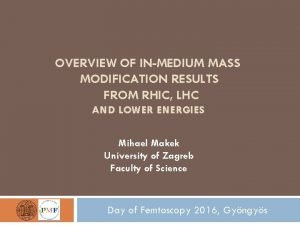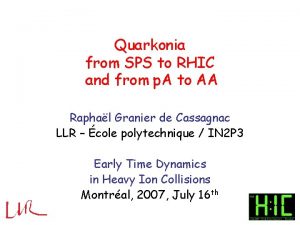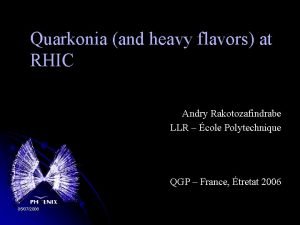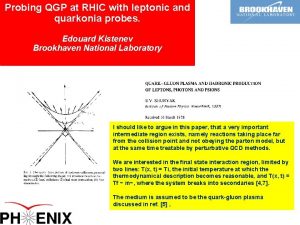InMedium Quarkonia at RHIC and LHC Ralf Rapp

![1. ) Introduction: A “Calibrated” QCD Force V [½ Ge. V] r [½ fm] 1. ) Introduction: A “Calibrated” QCD Force V [½ Ge. V] r [½ fm]](https://slidetodoc.com/presentation_image/b943ca07901c186b76c9ba021c5c6491/image-2.jpg)







![3. 2. 1 J/y Predictions at LHC [Zhao+RR ‘ 11] • regeneration becomes dominant 3. 2. 1 J/y Predictions at LHC [Zhao+RR ‘ 11] • regeneration becomes dominant](https://slidetodoc.com/presentation_image/b943ca07901c186b76c9ba021c5c6491/image-10.jpg)
![3. 2. 2 J/y at LHC: v 2 [He et al ’ 12] • 3. 2. 2 J/y at LHC: v 2 [He et al ’ 12] •](https://slidetodoc.com/presentation_image/b943ca07901c186b76c9ba021c5c6491/image-11.jpg)







![3. 3. 3 J/y at LHC III: High-pt – ATLAS+CMS [Zhao+RR ‘ 11] • 3. 3. 3 J/y at LHC III: High-pt – ATLAS+CMS [Zhao+RR ‘ 11] •](https://slidetodoc.com/presentation_image/b943ca07901c186b76c9ba021c5c6491/image-19.jpg)





![gc [1/fm] 4. 2. 5. 2 Thermalization Rate from T-Matrix • thermalization 4 (2) gc [1/fm] 4. 2. 5. 2 Thermalization Rate from T-Matrix • thermalization 4 (2)](https://slidetodoc.com/presentation_image/b943ca07901c186b76c9ba021c5c6491/image-25.jpg)

![4. 3 J/y at Forward Rapidity at RHIC [Zhao+ RR ‘ 10] 4. 3 J/y at Forward Rapidity at RHIC [Zhao+ RR ‘ 10]](https://slidetodoc.com/presentation_image/b943ca07901c186b76c9ba021c5c6491/image-27.jpg)
- Slides: 27

In-Medium Quarkonia at RHIC and LHC Ralf Rapp Cyclotron Institute + Dept. of Physics & Astronomy Texas A&M University College Station, TX USA Workshop on “Newest Quarkonia Results” RHIC & AGS Annual Users’ Meeting BNL (Upton, NY), 17. -20. 06. 14
![1 Introduction A Calibrated QCD Force V ½ Ge V r ½ fm 1. ) Introduction: A “Calibrated” QCD Force V [½ Ge. V] r [½ fm]](https://slidetodoc.com/presentation_image/b943ca07901c186b76c9ba021c5c6491/image-2.jpg)
1. ) Introduction: A “Calibrated” QCD Force V [½ Ge. V] r [½ fm] [Kaczmarek et al ‘ 03] • Vacuum charm-/bottomonium spectroscopy well described • Confinement? ! Operational criterion: linear part of potential • most sensitive to J/y + ’ (EBCoul(J/y) ~ 0. 05 Ge. V vs. 0. 6 Ge. V exp. ) • nonperturbative treatment • potential approach in medium?

Outline 1. ) Introduction 2. ) Quarkonium Transport in Medium 3. ) Comparison to RHIC + LHC Data 4. ) Conclusions

2. ) Quarkonium Transport in Heavy-Ion Collisions • Inelastic Reactions: [PBM+Stachel ’ 00, Thews et al ’ 01, Grandchamp+RR ‘ 01, Gorenstein et al ’ 02, Ko et al ’ 02, Andronic et al ‘ 03, Zhuang et al ’ 05, Ferreiro et al ‘ 11, …] → c + c- + X detailed balance: J/y + g ← • Rate Equation: D - D J/y c- c J/y • Theoretical Input: Transport coefficients - chemical relaxation rate Gy - equililbrium limit Nyeq(ey. B, mc* , tceq) • Phenomenological Input: - J/y, cc, y’+c, b initial distributions [pp, p. A] - space-time medium evolution [AA: hydro, . . . ] Observables

2. 1 Thermal Charmonium Properties (a) Equilibrium Y number: • gc from fixed cc- number: • interplay of mc* and • constrain spectral shape by lattice-QCD correlators (b) Inelastic Y Width e y. B mc * q q • controlled by as (parameter) Gy

2. 2 Effect of Partial c-Quark Thermalization on J/y • Relaxation time ansatz: Nyeq (t) ~ Nytherm(t) · [1 -exp(-t/tceq)] Microscopic Calculation Impact on Regeneration [Zhao+RR ‘ 11] [Song, Han, Ko ‘ 12] • sensitivity of regeneration on charm-quark diffusion

3. 1 Inclusive J/y at SPS + RHIC Strong Binding (U) Weak Binding (F) [Zhao+RR ‘ 10] • as~0. 3, charm relax. tceq = 4(2) fm/c for U(F) vs. ~5(10) from T-matrix • different composition in two scenarios

3. 1. 2 J/y p. T Spectra + Elliptic Flow at RHIC (strong binding) • shallow minimum at low p. T • high p. T: formation time, b feeddown, Cronin • small v 2 limits regeneration, but does not exclude it

3. 1. 3 J/y Excitation Function: BES at RHIC PHENIX (forward y) STAR (central y) • suppression pattern varies little (expected from transport) [Grandchamp +RR ’ 02] • quantitative pp + p. A baseline critical to extract systematics
![3 2 1 Jy Predictions at LHC ZhaoRR 11 regeneration becomes dominant 3. 2. 1 J/y Predictions at LHC [Zhao+RR ‘ 11] • regeneration becomes dominant](https://slidetodoc.com/presentation_image/b943ca07901c186b76c9ba021c5c6491/image-10.jpg)
3. 2. 1 J/y Predictions at LHC [Zhao+RR ‘ 11] • regeneration becomes dominant • uncertainties in scc+shadowing • low p. T maximum confirms regeneration
![3 2 2 Jy at LHC v 2 He et al 12 3. 2. 2 J/y at LHC: v 2 [He et al ’ 12] •](https://slidetodoc.com/presentation_image/b943ca07901c186b76c9ba021c5c6491/image-11.jpg)
3. 2. 2 J/y at LHC: v 2 [He et al ’ 12] • further increase at mid-y

3. 3 (1 S) and (2 S) at LHC Weak Binding Strong Binding (1 S) → (2 S) → [Grandchamp et al ’ 06, Emerick et al ‘ 11] • sensitive to color-screening + early evolution times • clear preference for strong binding (U potential) • similar results by [Strickland ‘ 12]

4. ) Conclusions • Quarkonium discoveries in URHICs: - increase of J/y RAA SPS, RHIC → LHC - low-p. T enhancement - sizable v 2 - increasing suppression of ’ (e. B ’ ~ e. BJ/y ) • Predicted signatures of QGP transport + hadronization - controlled by quantitative description of RHIC+SPS data, lattice QCD • Implications - T 0 SPS (~230) < Tdiss(J/y, ’) < T 0 RHIC (~350) < T 0 LHC(~550) ≤ Tdiss( ) - confining force screened at RHIC+LHC - marked recombination of diffusing charm quarks at LHC • Uncertainties - input HF cross sections, HF thermalization - initial-state effects (final-state in d. Au, p. Pb? !)

2. ) Thermodynamic T-Matrix in QGP • Lippmann-Schwinger equation In-Medium - T-Matrix: Q-Q • potential Va real - propagator G ) • imaginary parts: unitarization (cuts in in-med. QQ QQ • simultaneous treatment of: - bound + scattering states - quarkonia (QQ) + heavy-quark diffusion (Qq, g) [Wong, Mannarelli+RR, Mocsy+Petreczky, Beraudo et al. , Song et al. , Riek+RR, …]

2. 2 Brueckner Theory of Heavy Quarks in QGP Input Process Q→Q 0 -modes 2 -body potential Quark selfenergy - QQ T-matrix Qq T-matrix Output Test quark-no. susceptibility spectral fcts. / eucl. correlat. lattice data - evolution QQ (rate equation) exp. data Q spectra + v 2 (Langevin)

2. ) Thermodynamic T-Matrix for Quarkonia in QGP • Lippmann-Schwinger equation In-Medium Q-Q T-Matrix: • potential Va strictly real • imaginary parts: unitarization (cuts in in-med. QQ propagator GQQ) q • gluo-dissosciation (coupled channel) [Bhanot+Peskin ‘ 85] q • Landau damping (HQ selfenergy)

2. 3 Free vs. Internal Energy in Lattice QCD F 1(r, T) = U 1(r, T) – T Free Energy. S 1(r, T) Internal Energy - potential • weak QQ • small m. Q* ~ m. Q + F 1(∞, T)/2 [Kaczmarek +Zantow ’ 05] • strong QQ potential, U = ‹H int› • large m. Q* ~ m. Q + U 1(∞, T)/2 • F, U, S thermodynamic quantities • Entropy: many-body effects

3. 2. 2 D-Meson Thermalization at LHC • to be determined…
![3 3 3 Jy at LHC III Highpt ATLASCMS ZhaoRR 11 3. 3. 3 J/y at LHC III: High-pt – ATLAS+CMS [Zhao+RR ‘ 11] •](https://slidetodoc.com/presentation_image/b943ca07901c186b76c9ba021c5c6491/image-19.jpg)
3. 3. 3 J/y at LHC III: High-pt – ATLAS+CMS [Zhao+RR ‘ 11] • underestimate for peripheral (spherical fireball reduces surface effects …)

3. 3. 4 Time Evolution of J/y at LHC Strong Binding (U) Weak Binding (F) • finite “cooking-time” window, determined by inelastic width [Zhao+RR ‘ 11]

3. 4 at RHIC and LHC Weak Binding Strong Binding RHIC → LHC → [Grandchamp et al ’ 06, Emerick et al ‘ 11] • sensitive to color-screening + early evolution times

3. 2 Charmonia in QGP: T-Matrix Approach • U-potential, selfconsist. c-quark width • Spectral Functions - J/y melting at ~1. 5 Tc - cc melting at ~Tc - Gc ~ 100 Me. V • Correlator Ratios - rough agreement with l. QCD within uncertainties [Mocsy+ Petreczky ’ 05+’ 08, Wong ’ 06, Cabrera+RR ’ 06, Beraudo et al ’ 06, Satz et al ’ 08, Lee et al ’ 09, Riek+RR ’ 10, …] [Aarts et al ‘ 07]

3. 2. 2 T-matrix Approach with F-Potential • selfcons. c-quark width • Spectral Functions - J/y melting at ~1. 1 Tc - cc melting at ≤ Tc - Gc ~ 50 Me. V • Correlator Ratios - slightly worse agreement with l. QCD [Riek+RR ’ 10] [Aarts et al ‘ 07]

3. 3 Charm-Quark Susceptibility in QGP → G→ 0 2 → m «T [Riek+RR ‘ 10] • sensitive to in-medium charm-quark mass • finite-width effects can compensate in-medium mass increase
![gc 1fm 4 2 5 2 Thermalization Rate from TMatrix thermalization 4 2 gc [1/fm] 4. 2. 5. 2 Thermalization Rate from T-Matrix • thermalization 4 (2)](https://slidetodoc.com/presentation_image/b943ca07901c186b76c9ba021c5c6491/image-25.jpg)
gc [1/fm] 4. 2. 5. 2 Thermalization Rate from T-Matrix • thermalization 4 (2) times faster using U (F) as potential than pert. QCD • momentum dependence essential (nonpert. effect ≠ K-factor!) [Riek+RR ‘ 10]

3. 1. 3 Momentum Dependence of Inelastic Width • dashed lines: gluo-dissociation • solid lines: quasifree dissociation _ • similar to full NLO calculation [Zhao+RR ‘ 07] [Park et al ‘ 07]
![4 3 Jy at Forward Rapidity at RHIC Zhao RR 10 4. 3 J/y at Forward Rapidity at RHIC [Zhao+ RR ‘ 10]](https://slidetodoc.com/presentation_image/b943ca07901c186b76c9ba021c5c6491/image-27.jpg)
4. 3 J/y at Forward Rapidity at RHIC [Zhao+ RR ‘ 10]
 Ralf rapp
Ralf rapp Rhic brookhaven
Rhic brookhaven Rhic ags users meeting 2020
Rhic ags users meeting 2020 Rhic
Rhic Rhic
Rhic Rapp method
Rapp method Rapp method
Rapp method Geoglam rapp
Geoglam rapp Krachtenmodel van rapp
Krachtenmodel van rapp C# duck typing
C# duck typing Ralf armbruster
Ralf armbruster Ralf kopytziok
Ralf kopytziok Urlaub ito
Urlaub ito Ralf habel
Ralf habel Rückfallprävention
Rückfallprävention Ralf schenkel
Ralf schenkel Powerpoint entwurfsvorlagen
Powerpoint entwurfsvorlagen Pamela ralf
Pamela ralf Ralf averbeck
Ralf averbeck Ralf behnke
Ralf behnke Ralf ehrlich
Ralf ehrlich Dr. ralf kirchhoff
Dr. ralf kirchhoff Dr. ralf goebel
Dr. ralf goebel Michael kudenov
Michael kudenov H
H Ralf bendrath
Ralf bendrath Hausmodell dahrendorf
Hausmodell dahrendorf Ralf bundschuh
Ralf bundschuh
